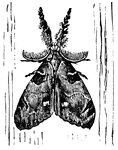Clipart tagged: ‘tussock’

White-marked Tussock Caterpillar
Orgyia leucostigma, the White-marked tussock moth, is a moth in the family Lymantriidae. The caterpillar…

Tussock Grass
"Tussock Grass is a large grass, same genus with the cock's-foot grass of the United States; native…
Brown-tail Moth Web
The Brown-tail (Euproctis chrysorrhoea) is a moth of the family Lymantriidae. It is distributed throughout…

Tussock Moth
Tussock Moths, Lymantriidae or Liparidae, are a family of moths with about 350 known genera and over…